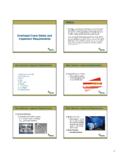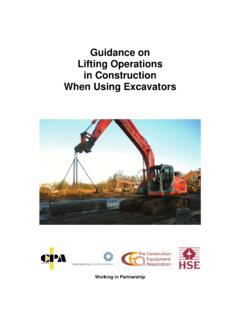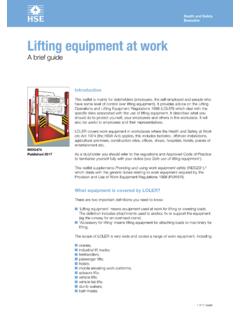Transcription of LIFTING & MECHANICAL HANDLING GUIDELINES - Hadimpro
1 LIFTING & MECHANICAL HANDLING GUIDELINES Working together to continuously improve our safety performanceRevision 2, June 2013 1 1. Preface 22. Responsibilities Responsible Person Competent Person Competent LIFTING Team Lift Supervisor or Person in Charge Technical Support 33. The Lift Define the lift Plan the Lift LIFTING Operation Risk Assessment Technical Support Finalising the Lift Plan and LIFTING Operation Risk Assessment Selection of LIFTING Equipment Examination and Inspection of the LIFTING Equipment Selecting Competent Personnel Perform the Lift Learn and Record 74. Training and Competency Personnel Undertaking LIFTING and MECHANICAL HANDLING Operations Personnel who Plan LIFTING Operations 105. Monitoring, Audit and Review 116. Summary 12 Appendix 1 13 Appendix 2 14 Appendix 3 21 Appendix 4a 22 Appendix 4b 23 Appendix 5 24 Key Terms and Definitions 28 ContentsLifting and MECHANICAL GuidelinesC LTCPCPLIFT PLANNING FLOWCHARTE very LIFTING operation should be planned and assessed using the process described need for LIFTING operationInform CP of need for LIFTING operationUndertake initial assessment of the proposed LIFTING operationIs there an existing LP/RA for the LIFTING operation?
2 Develop a new LPAre there any hazards which are not generic hazards?Go to Review and ApproveAssess and document the risk and control measures of these new these risks ALARP?Review and modify existing LP/RA where required?INITIATEINITIAL ASSESSMENT AND DEVELOPMENTLIFTING OPERATIONS RISK ASSESSMENT PROCESSREVIEW AND APPROVEEXECUTE AND DEBRIEFCan further mitigation methods be identified?Stop planning lift and investigate other methods of moving loadModify LP/RA to include additional risk mitigation measuresFinalise LP and RA for approval Review and approve LP and RA Has the work party reviewedand accepted the LP/RAModify LP/RA as requiredComplete toolbox talk with the aid of appropriate TBT cardCarry out LIFTING operation whilst continuing to assess the risksAfter completing the LIFTING operation, complete debrief to identify lessons learned and communicate to CPSTARTYESNONOYESYESYESYESYESNONONOYESNO RPRPCPCPCPCPCPCPCPCPCPC LTC LTC LTACTIONDECISIONENDRP This refers to the Responsible Person who identifies the need for a LIFTING operation and informs the CPCP This refers to the LIFTING Competent Person who will develop LIFTING plans and risk assessmentsLS This refers to the LIFTING Supervisor who is responsible for the supervision of the LIFTING operationsC LT This refers to the Competent LIFTING TeamLP LIFTING PlanRA Risk AssessmentTBT Tool Box TalkNOTES (SEE SECTION 2 RESPONSIBILITIES) 302 Incidents during LIFTING and MECHANICAL HANDLING Operations continue to occur and thesehave resulted in serious injuries and fatalities.
3 To ensure these operations are carried out in a safe manner they must be properly planned and be undertaken by competent personnel using appropriately selected LIFTING GUIDELINES define the responsibilities, training, competencies and assessment of those involved in LIFTING and MECHANICAL HANDLING operations, and sets out a structured approach aimed at ensuring that such operations are adequately risk assessed and systematically also provide examples of key documents such as lift plans which can be used whereno similar document exists, or to benchmark those that GUIDELINES are therefore intended to assist all personnel involved in LIFTING and MECHANICAL HANDLING operations to enable such operations to be carried out in a safe andconsistent manner. In particular, this document provides guidance to those persons who risk assess and plan these operations, and to the supervisors of the personnel process illustrated inside the front cover has been designed to be practical and easy to company or organisation should ensure that all personnel involved in LIFTING and MECHANICAL HANDLING operations clearly understand their roles and deficiencies in training and competence have been highlighted, it is the duty of theemployer to take appropriate action to address this the first publication of these GUIDELINES the offshore industry has adopted the principles identified in the GUIDELINES with particular emphasis placed on the developmentand use of LIFTING plans.
4 Although great strides have been made and LIFTING incidents havereduced, unfortunately they still occur. A common theme when such incidents occur is thefailure to identify site specific hazards with the LIFTING operations risk assessment, instead focussing on the generic hazards common to LIFTING revision of the GUIDELINES advocates a new approach with the risk assessment and toolbox talk process. In addition it advocates that for every LIFTING operation there must bea LIFTING plan that has been authorised by the Competent Change in Safety expects those member organisations responsible for ensuring that LIFTING and MECHANICAL HANDLING operations are carried out safely will adopt these GUIDELINES as a minimum standard in respect of the matters they cover, and that they willfind ways to exceed and improve upon what is defined PrefaceEveryone involved in LIFTING and MECHANICAL HANDLING operations has specific responsibilitiesand must be able to demonstrate the required level of competency to undertake the roleand task Responsible PersonThe Responsible Person is the person who has overall responsibility for work activities.
5 This person may be the Shift Supervisor, Base Manager, Project Engineer or Toolpusher, for example. The Responsible Person recognises, or is advised of, the need for a LIFTING activity. The Responsible Person should then inform the appointed Competent Person of the loads involved, the location, the timescales etc to allow the Competent Person to begin the planning Competent PersonThe Competent Person is someone who has the required level of competency to be ableto produce written plans for the undertaking of LIFTING operations and be able to review and authorise plans that have been written by others. A site visit should be undertaken prior to authorisation. They must have the practical skills and theoretical knowledge to plan LIFTING operations, undertake risk assessments and conduct toolbox talks. The Competent Person may or may not supervise the LIFTING operation but is the focal point of authority for all the technical aspects associated with a LIFTING operation.
6 They must know their competency limitations, work within them and know when technical support is required. The level of competency required to perform this role is included in Section of this Competent Person or the Responsible Person will be responsible for appointing the LIFTING team who will undertake the LIFTING operation together with the lift supervisor whowill be in control of the LIFTING operation. They must ensure that the team members have the correct competencies to enable them to complete the LIFTING operation in a safe and controlled Competent LIFTING TeamEach team member has the responsibility to know and work within their own level of competency to complete the job safely. They are required to attend and participate in toolbox talks, carry out pre-use and post-use inspections of LIFTING equipment and stop any operation when they are concerned about its Lift Supervisor or Person in ChargeThe nominated lift supervisor is the person in direct control of the LIFTING operation and thelifting team at site.
7 This will generally be a member of the LIFTING Team, and in the case ofa crane LIFTING operation this would be the should be proportionate to the exposure of risk created by the LIFTING operation and the experience and capabilities of the personnel involved in individual LIFTING Technical SupportThose providing technical support must be technically competent in the area of expertiseupon which they are requested to ResponsibilitiesLifting and MECHANICAL Guidelines45 LIFTING and MECHANICAL Define the liftIdentify LIFTING ActivityThe Responsible Person should identify or be informed of the need for a LIFTING operationand inform the Competent Person. The Competent Person will plan and, if appropriate, supervise the LIFTING Scope of WorkThe Competent Person must begin their planning process by determining the scope of work defining what is to be done, who should be involved, how it will be may require an initial lift plan, sketches, notes etc.
8 If additional technical support is required then it should be obtained before Plan the LiftThe normal hazards associated with LIFTING operations should be grouped together as generic hazards (see appendix 1) and the duty holder will need to have the required control measures in place to address these. In essence these control measures are always running in the background and do not need to be included in the LIFTING operations risk assessment or discussed at the toolbox talk. The LIFTING operations risk assessment and toolbox talk should then become more focused on the LIFTING operations, discussing the LIFTING plan, identifying the site-specific hazards with the associated control measures and allocating team members specific responsibilities. The duty holder would still need to have these generic hazards addressed in a documented risk assessment and within their safety management system to identify how the continued operation of the control measures will be duty holders have systems in place to categorise a LIFTING operation in terms of its complexity, such as routine or non-routine and simple, complex or complicated.
9 Such classification can be of assistance during the planning process by giving details of the actions that are required of the Competent Person for each LIFTING operation LIFTING plan will detail the step-by-step instructions and the LIFTING equipment , during the drafting of the LIFTING plan, hazards are identified that are not part of the generic hazards for LIFTING operations, or they cannot be eliminated in the LIFTING plan, thenthese will need to be addressed in the LIFTING operations risk assessment and the control measures identified. This LIFTING operations risk assessment will need to be attached to thelifting plan and discussed at the toolbox The LIFTING Operation Risk AssessmentUpon completion of the draft LIFTING plan, the Competent Person must identify any hazardswhich are not generic hazards (see appendix 1). Where such hazards remainthen they must be addressed in a LIFTING operation risk Competent Person should avoid recording the generic hazards controls, where suchhazards have already been recognised as continuously re-occurring and are eliminated orcontrolled by identified processes already in place.
10 This will then allow the risk assessmentprocess to focus on the specific hazards associated with the LIFTING operation. Following this stage the LIFTING plan and risk assessment may require further technical a LIFTING operation risk assessment already exists for the LIFTING operation the Competent Person must determine whether any changes are required. Any such changesshould be identified and captured during the review of the existing LIFTING Technical SupportIn the planning stage of the LIFTING operation, there will be occasions when the CompetentPerson identifies the need for additional technical support. A technical review isundertaken by someone who has the necessary competencies to make an informed andimpartial judgement on the lift plan. This may range from another Competent Person reviewing the lift plan to the involvement of a structural engineer to check the loadings on beams or laydown areas.





